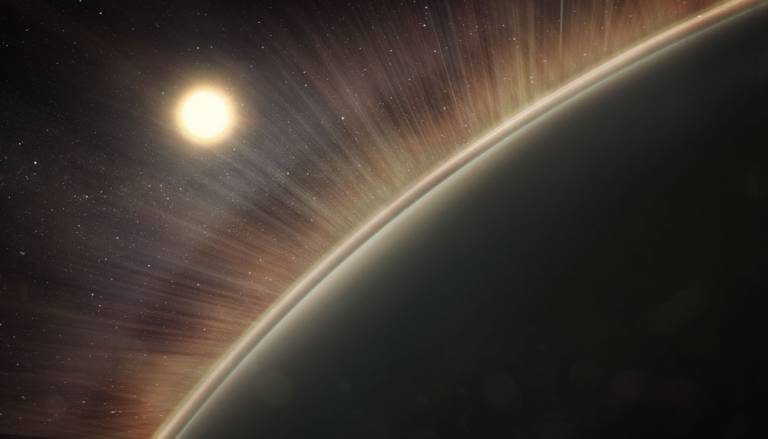Strong 'electric wind' strips planets of oceans and atmospheres
20 June 2016
Venus has an 'electric wind' strong enough to remove the components of water from its upper atmosphere, which may have played a significant role in stripping the planet of its oceans, according to a new study by NASA and UCL researchers.

"It's amazing and shocking," said Dr Glyn Collinson, previously at UCL Mullard Space Science Laboratory and now a scientist at NASA's Goddard Space Flight Center. "We never dreamt an electric wind could be so powerful that it can suck oxygen right out of an atmosphere into space. This is something that definitely has to be on the checklist when we go looking for habitable planets around other stars."
The study, published today in the journal Geophysical Research Letters, discovered that Venus' electric field is so strong that it can accelerate the heavy electrically charged component of water - oxygen - to speeds fast enough to escape the planet's gravity.
When water molecules rise into the upper atmosphere, sunlight breaks the water into hydrogen ions which are fast and escape easily, and heavier oxygen ions which are carried away by the electric field.
Co-author, Professor Andrew Coates of UCL MSSL, who leads the electron spectrometer team, said, "We've been studying the electrons flowing away from Titan and Mars as well as from Venus, and the ions they drag away to space to be lost forever. We found that over 100 metric tons per year escapes from Venus by this mechanism - significant over billions of years. The new result here is that the electric field powering this escape is surprisingly strong at Venus compared to the other objects. This will help us understand how this universal process works."
Venus is the planet most like Earth in terms of its size and gravity, and evidence suggests it once had oceans worth of water which boiled away to steam long ago with surfaces temperatures of around 860 degrees Fahrenheit (460 Centigrade). Yet Venus' thick atmosphere, about 100 times the pressure of Earth's, has 10,000 to 100,000 times less water than Earth, suggesting something removed all the steam.
Scientists thought it was the solar wind eroding the remainder of an ocean's worth of oxygen and water slowly from Venus' upper atmosphere, but the new findings suggest it was an aggressive electric wind instead.
Just as every planet has a gravity field, it is believed that every planet with an atmosphere is also surrounded by a weak electric field. While the force of gravity is trying to hold the atmosphere on the planet, the electric force can help to push the upper layers of the atmosphere off into space.
The team discovered Venus' electric field using the NASA-SwRI-UCL electron spectrometer, which is part of a larger instrument called ASPERA-4 aboard the ESA Venus Express. When monitoring electrons flowing out of the upper atmosphere, they noticed the electrons were not escaping at their expected speeds because they were being tugged on by Venus' potent electric field. By measuring the change in speed, the team found the strength of the field to be much stronger than expected, and at least five times more powerful than at Earth.
"We don't really know why it is so much stronger at Venus than Earth," said Collinson, "but, we think it might have something to do with Venus being closer to the sun, and the ultraviolet sunlight being twice as bright. It's a really challenging thing to measure and to date all we have are upper limits on how strong it might be here."
Another planet where the electric wind may play an important role is Mars. NASA's MAVEN mission is currently orbiting Mars to determine what caused the Red Planet to lose much of its atmosphere and water.
Professor Coates added, "With ESA's Mars Express, we have already caught this process in action at Mars, and MAVEN can now determine its relative importance. With NASA's Cassini spacecraft we found that Titan loses 7 metric tonnes per day this way."
Understanding the role played by planet's electric winds will help astronomers improve estimates of the size and location of habitable zones around other stars. "Even a weak electric wind could still play a role in water and atmospheric loss at any planet," said Dr Alex Glocer of NASA Goddard, a co-author on the paper. "It could act like a conveyor belt, moving ions higher in the ionosphere where other effects from the solar wind could carry them away."
Links
- Research paper in Geophysical Research Letters
- Professor Andrew Coates' academic profile
- UCL Mullard Space Science Laboratory
- NASA's Goddard Space Flight Center
- ESA's Venus Express
Images
- Venus' electric wind (credit: Dr Glyn Collinson)
Media contact
Bex Caygill
Tel: +44 (0)20 3108 3846
Email: r.caygill [at] ucl.ac.uk
 Close
Close

